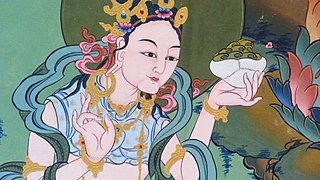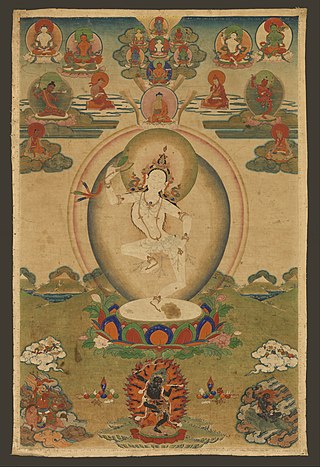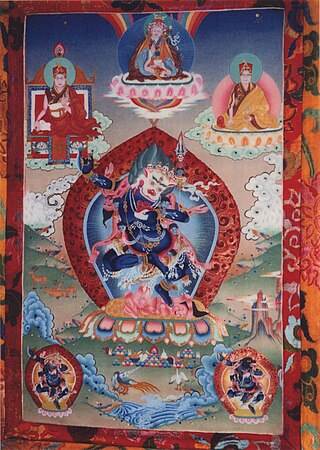


The Mata Kuan Rani Temple, or 'Princess of the Well Temple', is situated near the bank of the Beas River in the town of Mandi, Himachal Pradesh, India. This is the place where the princess Mandarava was imprisoned by her father.



The Mata Kuan Rani Temple, or 'Princess of the Well Temple', is situated near the bank of the Beas River in the town of Mandi, Himachal Pradesh, India. This is the place where the princess Mandarava was imprisoned by her father.
The slate-roofed temple over a deep well is dedicated to the 'Princess of the Well' and celebrates the time when, according to legend, Princess Mandarava (man da ra ba me tog), the Princess of Zahor (or Sahor), which is usually identified with Mandi, though some scholars place it in eastern India), [1] became a consort of Padmasambhava (Tibetan: Guru Rinpoche).
Mandarava, the daughter of King Arshadhara and Queen Mohauki,. [2] is said to have been born a prodigy and an 'Awareness Dakini' (yes-shes mkha'-'gro) and was very beautiful. She refused all offers of marriage and fed her father the flesh of a Brahmin (a terrible offence), left the palace, and took on the robes of a beggar. She was ordained by the famous Buddhist scholar Śāntarakṣita, who is also said to have been a native of Zahor, and came to terms with her father who provided a palace for her meditation. When Padmasambhava came to Zahor from Orgyen, she fell for him and became his disciple. [3]
The king became incensed and condemned them both to death in a fire which raged for seven days. After the smoke cleared there was a lake with a lotus in it, Rewalsar (Tibetan: Tso Pema or 'Lotus Lake'), which is situated about 24 km from Mandi. [4] This convinced the king of the wisdom and power of Padmasambhava and he requested teachings from him and gave his daughter permission to pursue her religious destiny. [5]
The temple is sacred to both Tibetan Buddhists and Hindus, and was commonly visited by Tibetan pilgrims and traders before the invasion of Tibet by the Chinese when the borders were closed with India.

Padmasambhava, also known as Guru Rinpoche and the Lotus from Oḍḍiyāna, was a tantric Buddhist Vajra master from India who taught Vajrayana in Tibet. According to some early Tibetan sources like the Testament of Ba, he came to Tibet in the 8th century and helped construct Samye Monastery, the first Buddhist monastery in Tibet. However, little is known about the actual historical figure other than his ties to Vajrayana and Indian Buddhism.

Yeshe Tsogyal, also known as "Victorious Ocean of Knowledge", "Knowledge Lake Empress", or by her Sanskrit name Jñānasāgara "Knowledge Ocean", or by her clan name "Lady Kharchen", attained enlightenment in her lifetime and is considered the Mother of Tibetan Buddhism. Yeshe Tsogyal is the highest woman in the Nyingma Vajrayana lineage. Some sources say she, as Princess of Karchen, was either a wife or consort of Tri Songdetsen, emperor of Tibet, when she began studying Buddhism with Padmasambhava, who became her main karmamudrā consort. Padmasambhava is a founder-figure of the Nyingma tradition of Tibetan Buddhism, and is considered as a second buddha of our era. She is known to have revealed terma with Padmasambhava and was also the main scribe for these terma. Later, Yeshe Tsogyal also hid many of Padmasambhava's terma on her own, under the instructions of Padmasambhava for future generations.

Mindrolling Jetsün Khandro Rinpoche is a lama in Tibetan Buddhism. Born in Kalimpong, India and the daughter of the late Mindrolling Trichen, Khandro Rinpoche was recognized by Rangjung Rigpe Dorje, 16th Karmapa at the age of two as the reincarnation of the Great Dakini of Tsurphu Monastery, Urgyen Tsomo, who was one of the most well-known female masters of her time. Khandro Urgyen Tsomo was the consort to Khakyab Dorje, 15th Karmapa Lama (1871–1922) and recognised in this Buddhist tradition as an incarnation of Yeshe Tsogyal. Her name is in fact her title, Khandro being Tibetan for dakini and rinpoche an honorific usually reserved for tulkus that means "precious one."
Tertön is a term within Tibetan Buddhism meaning a person who is a discoverer of ancient hidden texts or terma. Many tertöns are considered to be incarnations of the twenty five main disciples of Padmasambhava, who foresaw a dark time in Tibet. He and his consort Yeshe Tsogyal hid teachings to be found in the future to benefit beings. A vast system of transmission lineages developed. Scriptures from the Nyingma school were updated by terma discoveries, and terma teachings have guided many Tibetan Bon and Buddhist practitioners.

Kyabje Dudjom Jigdral Yeshe Dorje was known as Terchen Drodül Lingpa and as Dudjom Rinpoche. He is considered by many Tibetan Buddhists to be from a line of important Tulku lineage, and a renowned Tertön. Lineage wise, he was a direct incarnation of both Padmasambhava and Dudjom Lingpa (1835–1904). He was a Nyingma householder, yogi, and a Vajrayana and Dzogchen master. According to his disciple Khenpo Tsewang Dongyal, he was revered as "His Holiness" and as a "Master of Masters".

Ayu Khandro, also known as Dorje Paldrön, lived from 1839 to 1953. She was a practitioner, yogini, and terton of Tibetan Buddhism in Eastern Tibet. An accomplished Dzogchen meditator, she is renowned for her extensive pilgrimages throughout Tibet, long periods of dark retreat practice, the gongter of the practice of the yidam Senge Dongma, various forms of Chöd, and her lifelong dedication to spiritual practice.

Machig Labdrön, or "Singular Mother Torch from Lab", 1055-1149) was a female Tibetan Buddhist monk believed to be a reincarnation of Yeshe Tsogyal, and the renowned 11th-century Tibetan tantric Buddhist master and yogini that originated several Tibetan lineages of the Vajrayana practice of Chöd.

Vajrayoginī is a Tantric Buddhist female Buddha and a ḍākiṇī. The Vajrayogini cult dates back to the tenth and twelfth centuries. Vajrayoginī's essence is "great passion" (maharaga), a transcendent passion that is free of selfishness and illusion—she intensely works for the well-being of others and for the destruction of ego clinging. She is seen as being ideally suited for people with strong passions, providing the way to transform those passions into enlightened virtues.

Rewalsar or Tso Pema in Tibetan is a small town and a pilgrimage place in a nagar panchayat in Mandi district in India. It is located in the state of Himachal Pradesh. The local name for Rewalsar is Tri Sangam. Rewalsar Lake is a tourist spot in the area.

Rewalsar Lake, also known as Tso Pema, is a mid-altitude lake located in the mountains of the Mandi district in Himachal Pradesh, India. It is located 22.5 km south-west from the town of Mandi, at an elevation of about 1,360 metres (4,460 ft) above sea level, with a shoreline of about 735 m. Rewalsar Lake is a sacred spot for Hindus, Sikhs and Buddhists, and sacred to Tibetan Buddhists for the Vajrayana practices of Padmasambhava and Mandarava, which are credited for the lake's creation.

Mandarava was, along with Yeshe Tsogyal, one of the two principal consorts of great 8th-century Indian Vajrayana teacher Padmasambhava, a founder-figure of Tibetan Buddhism. Mandarava is considered to be a female guru-deity in Tantric Buddhism or Vajrayana.

Jetsunma Ahkon Lhamo is a tulku within the Palyul lineage of the Nyingma tradition of Tibetan Buddhism. She gained international attention when she, a western woman, was enthroned as a reincarnated lama. Since the mid-1980's she has served as spiritual director for Kunzang Odsal Palyul Changchub Choling, a Buddhist center in Poolesville, Maryland, which includes a large community of western monks and nuns. She also founded a center in Sedona, Arizona, U.S.A., and has small communities of students in California and Australia. Ahkon Lhamo has been described by her teachers, Tibetan lamas Penor Rinpoche, Gyaltrul Rinpoche, as well as others such as Jigme Phuntsok, as a dakini or female wisdom being.

Palyul Monastery, also known as Palyul Namgyal Jangchub Choling Monastery and sometimes romanized as Pelyul Monastery, is one of the "Six Mother Monasteries" of the Nyingma tradition of Tibetan Buddhism. It was founded in 1665 by Rigzin Kunzang Sherab in Pelyul in Baiyü County, Garzê Tibetan Autonomous Prefecture in China's Sichuan province, on the eastern edge of Tibet in Kham. The monastery is the seat of the Nam Chö Terma of Terton Migyur Dorje. Drubwang Padma Norbu was the 11th throneholder of the Palyul lineage. Upon his mahaparinirvana in March, 2009, Karma Kuchen Rinpoche became the 12th throneholder.
Orgyen Kusum Lingpa (1934-2009) was a Tibetan terton and Nyingma lineage holder within Tibetan Buddhism. His name means "Holder of the Sanctuary of the Trikaya of Oddiyana Padmasambhava."
Yeshe is a Tibetan term meaning wisdom and is analogous to jnana in Sanskrit. The word appears for example in the title of the Lamrim Yeshe Nyingpo, a Vajrayana Buddhist sacred scripture that records oral teachings of Padmasambhava in the 9th century, and in the name of Yeshe Walmo, a deity of the Tibetan religion of Bon. It is used as a unisex given name by Tibetans and Bhutanese people, also spelled Yeshey, Yeshay, or Yeshi.

The Yarlung Valley is formed by Yarlung Chu, a tributary of the Tsangpo River in the Shannan Prefecture in the Tibet region of China. It refers especially to the district where Yarlung Chu joins with the Chongye River, and broadens out into a large plain about 2 km wide, before it flows into the Tsangpo River. It is situated in Nedong District of the Shannan Prefecture and includes the capital of the prefecture, Tsetang, one of Tibet's largest cities, 183 km southeast of Lhasa.
Ta Rimochan or Ti Rimochen is a Buddhist monastery in Bhutan belonging to the Nyingma school of Tibetan Buddhism.

Urgyen Tsomo (1897–1961) was a prominent Tibetan Buddhist female master who was known as the Great Dakini of Tsurphu. She was the consort of the Khakyab Dorje, 15th Karmapa Lama. She was considered by other masters to be the reincarnation (emanation) of Yeshe Tsogyal, the wife of Padmasambhava of the 8th century, who spread Buddhism in Tibet.
Atsara Salé was an 8th-century practitioner of Vajrayana Buddhism from South India. A student of both the dakini Yeshe Tsogyal and the great master Padmasambhava, the co-founders of Tibetan Buddhism. He is known for being one of Yeshe Tsogyal's main consorts along with Padmasambhava, and for writing one of Yeshe Tsogyal's biographies.

In Tibetan Buddhism, Siṃhamukhā or Siṃhavaktra, also known as the Lion Face Dakini or Lion-headed Dakini, is a wisdom dakini of the Dzogchen tradition. She is represented as a fierce dakini with the head of a snow lion. Her mouth is depicted with a roar, symbolizing untamed fury and jubilant laughter. Her roar disperses discursive thoughts. She is naked, symbolizing that she herself is completely free of discursive thought.
| Part of a series on |
| Tibetan Buddhism |
|---|
 |